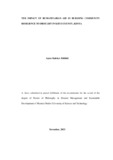| dc.description.abstract | In Kenya, droughts influenced by climate change have become more protracted and severe. Arid and semi-arid lands have been disproportionately affected due to their fragile ecosystems, unfavourable climate, and historical marginalization. Kitui County, an arid and semi-arid County has endured the brunt of protracted droughts. Despite the growing global, regional, and national attention in building community resilience to disasters, there is a paucity of research examining the impact of humanitarian aid in building community resilience to drought in Kitui County. The overall objective of this study was to bridge this gap by examining the impact of humanitarian aid in building community resilience to drought in Kitui County. To achieve this overall objective, three objectives were formulated i) to examine the types of humanitarian aid implemented in response to drought disaster in Kitui County; ii) to determine the level of community resilience to drought in Kitui County; and iii) to evaluate strategic options for enhancing community resilience to drought in Kitui County. The study was conducted in Mwingi North and Mwingi West Sub-Counties which were selected using purposive sampling technique. The study utilized data collected from 385 households sampled using systematic sampling techniques. Descriptive, correlation, and evaluation research designs were used. Results based on descriptive analysis revealed the types of humanitarian aid implemented in response to drought disaster in Kitui County include food support 77%, planting of drought resilient crops 11.7%; awareness creation on drought mitigation measures 9.6% among others with food support being the most prominent. The impact of humanitarian aid in building community resilience to drought was significant at p-value = 0.000. On the level of community resilience to drought, the results based on descriptive statistics revealed that 89.4% of the household respondents earned their income from crop and livestock production, income sources which are highly sensitive to drought risks, 62.6% had no food in store and, 67%, earned less than Ksh.5,700 monthly. On strategic options for enhancing community resilience to drought in Kitui County, support for sustainable water sources was ranked highest at 34.4%; while community engagement in disaster risk assessments was ranked lowest at 5.5%. In conclusion, the study found that humanitarian aid has had an impact in increasing community resilience to drought in Kitui County. However, to expedite progress in realizing the objectives of the Sendai Framework for Disaster Risk Reduction 2015-2030 and the Sustainable Development Goals, the study recommends a shift from the current humanitarian focus on immediate emergency response to a broader approach addressing longer-term community resilience building needs during the recovery and reconstruction phases of drought response. Emphasizing strategic policy options, it recommends increased humanitarian aid investment for constructing sustainable water supply systems, expanding access to credit facilities, implementing livestock and crop insurance, and establishing food banking facilities for drought-affected communities in Kitui County and other regions. This study offers insights for improving the impact of humanitarian aid in enhancing community resilience to drought, serving as a valuable academic reference. | en_US |

